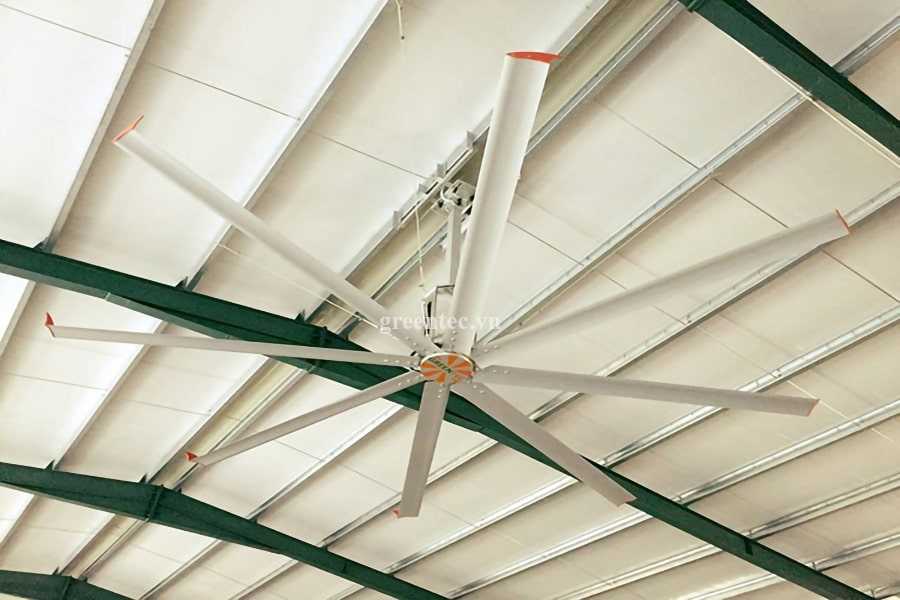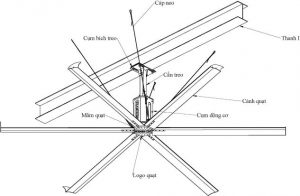
13 Dec What is HVLS Fans?
What is HVLS Fans?
HVLS Fans are commonly known as industrial ceiling fans, HVLS industrial ceiling fans, big ceiling fans, factory ceiling fans, high power ceiling fans, HVLS ceiling fans, size ceiling fans. large fan, long wing industrial ceiling fan, energy saving ceiling fan …
Technically, HVLS fans are usually ceiling fans, although some are fitted with a large, wing-span industrial ceiling fan – the ceiling fan diameter is usually greater than 2.1 m. HVLS ceiling fans move slowly and distribute large amounts of air at low rotational speeds, hence the name “large flow, low speed”.
Typical applications for HVLS ceiling fans in two industrial and commercial categories. HVLS ceiling fans were originally designed for large spaces such as barns, factories, warehouses, factories. HVLS ceiling fans are also used in commercial spaces, where air conditioners are more popular, but the air movement increased from ceiling fans can increase user comfort effectively or prevent prevent stratification. Typical commercial applications include shopping malls, churches, office buildings, airport terminals, fitness centers and schools.
An important concern for many commercial spaces, such as schools and libraries, is sound sensitivity and quiet operation. In contrast, industrial space has dBA of 85 or more median and prioritizes air movement (effective in combating heat stress) in silent operation.
Principle of operation of the HVLS Fans
HVLS ceiling fan operate under cool moving air principles that break the saturated boundary layer around the body and increase the evaporation rate to create a cooling effect. HVLS ceiling fan create an air column when they rotate. This air column moves down and along the floor. This horizontal airflow is related to the diameter of the fan and to a lesser extent the fan speed.
Ideally, an 8-foot (2.4 m) fan creates a floor air flow of about 36 inches (910 mm) deep. A 24-foot fan (7.3 m) creates a floor air of 108 inches (2,700 mm) deep, high enough to submerge a person standing on the floor or a cow, the original purpose of development. it.
Commercial HVLS fans are different from residential ceiling fans related to diameter, rotational speed and performance. While some fans use modern rotors to move the air, other methods are being used to make it more efficient than using airplanes.
HVLS fans benefits
Air movement can have a significant effect on human thermal comfort. Cold winds in cold conditions are considered unfavorable, but moving air in neutral to warm environments is considered beneficial. This is because normally in conditions of an air temperature of about 74 ° F, the body needs to lose heat to maintain a constant internal temperature.
Unlike air conditioning, cool rooms, cooling fans. Ceiling fans increase air speed at the user level, enabling more efficient heat removal, cooling for occupants, instead of space. The increased air velocity increases the rate of convection heat loss and evaporation from the body, thus making the occupants feel cooler without changing the dry bulb temperature of the air.
Hot air is less dense than cold air, causing natural hot air to rise to the ceiling through a process called convection. In the static atmosphere, the coldest, coldest layers at the bottom and the warmest at the top. This is called stratification. The most effective and efficient air mixing in a stratified space is to push the hot air down to the level of occupancy. This allows complete mixing of air in space while reducing both heat loss through walls and roofs, and energy consumption of buildings. In order to avoid causing a draft, the fan should be running slowly so that the air speed at the level does not exceed 40 feet per minute (12 m / min).




No Comments